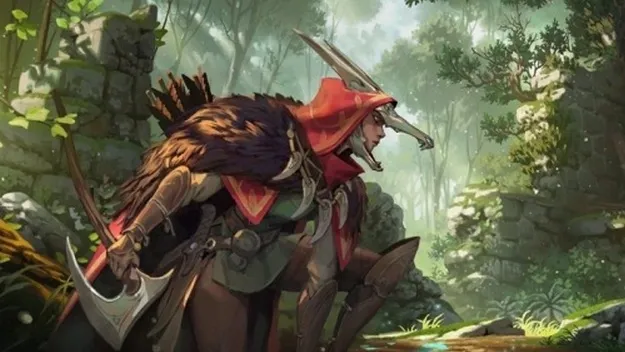Tunic - Review
Following the release of the Elden Ring, developers debated what makes a successful game experience for a player. We have a concept in one camp that allows the player to learn the laws of the game on his own, which can be exhausting and disgusting at times. On the other side, some games provide the player with everything he requires on a silver platter, which might lead to "leading by the hand." Tunic, a two-dimensional action/puzzle adventure that tries to fall between between the two styles stated, is coming out right now.
Tunic's idea is not to tell you anything, but to reveal absolutely everything - through collecting pages of in-game manuals. This manual is made in the style of guides written for games 30+ years ago, which means that it contains various illustrations and is visually attractive. And the manual includes all the elements of the game: tutorial, map, explanation of the story, etc.
I believe that at least a third of the time spent on the development of this manual was spent on the development of the game itself. Everything is beautifully arranged, interesting to watch, and, ultimately, informative and crucial for understanding the game itself. The tunic is deliberately deprived of all information without this in-game guide. The game starts without any introduction, you just wake up on the beach and have no idea what the plot of the story is or what your task is. You learn all this by collecting pages of manuals scattered around the world.
The idea is refreshing, but at the same time, it leaves room for Tunic to be uninteresting, vague, and frustrating to some players. You see, collecting pages of a manual that contains key things is not mandatory here. It can happen that you just don't notice some pages in time, skip them, and then in the next few hours, you will be left behind for something that would make the game easier for you or offer context for your adventure.
I realized that there is a sprint in the game only after 2-3 hours of playing
because the sprint button is also the dodge button, and the sprint cannot be
started without the dodge command. The game does not have a classic menu where
you can see the controls whenever you want, but here you must first find a
sheet of manuals with the controls. And instead of being proud of myself for
realizing it at all, I felt stupid because I could have saved time before I
knew it right from the start.
Initially, Tunic guides the player by
denying him some of the tools and weapons he needs to open his way to
previously inaccessible areas. But, after the first hour, you have the
opportunity to go in different directions, which is again as harmful as it is
liberating. There is some order in which a player should go from one area to
another, so his challenge gradually increases. However, the game doesn’t say
what that order is, so it’s easy to stray from the starting area to an area
where the weight jumps abruptly, and you’re not sure if that should be the
case or not.
The tunic is not in favor of the fact that it is full of hidden passages, but
not quite like in other games. Here, the passages are hidden from your eyes,
so they are usually behind an object or corner, so you can't notice them
because you can't control the camera. The nefarious part of this design is
that the camera itself is not stationary - it rotates in certain situations,
but when it suits the game, most often when you already find a hidden passage
that you have to "feel" by walking along the walls. It’s a targeted developer
decision that fits into the game’s overall mystery, but it’s not something
that would delight you like searching for hidden passages in the Monument
Valley series.
I didn't like that mysterious part of Tunic, but
other qualities made the game better. The system of advancement in Tunic is
well connected with the need for research. By taming your opponent you get the
main currency which is important, but for upgrades, you have to find the
appropriate items scattered around the world. The game rewards you if you are
thorough in peeking into every corner.
Any upgrade in health, seizures, stamina, or defects is very noticeable. You are not unlocking new powers, and the number of available weapons is very small, but you can, for example, increase the number of potions you are being treated with, which is very helpful in the fight. There are also perk cards that you also find by researching the environment, and the cool thing is that the game doesn't tell you what their effect is, so you discover it yourself by using it.
A good portion of the stuff is revealed in the manual I mentioned earlier, but
even when you have the linked pages of the manual, you can’t immediately
interpret just about everything. The text in the manual is written in a
foreign language, and you learn to interpret that language by playing. For
example, in the introduction, you have an inscription in front of the cave and
when you look at it for the first time you can't tell what is written on it.
When you enter the cave, you see what is there, and go back to the inscription
- you know how to translate the words that are written on it. I’m not entirely
sure how deep this mechanic goes, I’ve interpreted most things in Tunic
without any text, but it’s a nice bridge between the game saying nothing and
saying too much.
Visually, the game is a real candy and looks like
a cartoon for children - which is a compliment in this case. Stylistically it
is very similar to the remake of Link’s Awakening for the Switch, which is
again a good thing for anyone who doesn’t have access to a Nintendo console.
Luckily for Tunic, the technical side of the game is much tidier than Link’s
Awakening. The game is nicely optimized, I didn't come across a single bug,
and there was no crash in the PC version. The sound is also good, with
memorable melodies that are pleasant to listen to outside of the game itself.
Tunic most of the time is not a game that will make you break the controller
with its weight. It is true that here, too, all enemies are resurrected as
soon as you repeat a part, but by dying, you lose a very small part of the
coin that you can return on the way to the point where your fox fell. The
challenging part of the game is the showdown with rare boss opponents for whom
you have to work out a strategy and master your stamina.
Unlike the
challenge of groping hidden paths, Tunic is flexible and benevolent when it
comes to fighting, and the options allow the player to turn off the use of
stamina or even become immortal. I know that for many, these options will be
"below honor", but in the end, it is not below honor to pull a very vile move
to take away acquired upgrades as an artificial way to raise challenges or
extend durability.
The average duration of a Tunic is some 10-12 hours, depending on how often
you wander. Maybe a little too short for a $ 28 game, but there’s still a
choice because it’s also available as part of a Game Pass subscription. Since
there is no permanent demo version (which has appeared on Steam several
times), it may be wisest to try the game through a subscription because I have
the impression that it is not for everyone.
Tunic’s beautifully
illustrated guide is at the same time his blessing and curse. At one point in
an interesting way, it turns the tutorial and story into something you need to
earn through gameplay. The second moment can be tiring because you just want
to see the map, and it shows you a hundred other pieces of information. Or it
doesn’t point you to something that could save you a lot of time.
There
is a moment when all of Tunic’s cryptic and mystery should result in a big
surprise for the player himself. And one part of the audience will probably
like it. But as cunning as this performance may be to some, it may seem vile
to others. Now, I'm also secretive so I wouldn't spoil anything, but let's put
it this way: Tunic works by denying you information - to some, it will seem
like a smart thing, and some might feel cheated because of it.
It is nice that Tunic was made as a game in the 80s and '90s, a time when the secrets of the games have not yet been revealed on the Internet. It is safe to say that they do not do that anymore. But the same can be said that such a game cannot fully convey the same experience of mysterious adventures to today's audience. But despite all the frustrations that arise from this approach, I think we should appreciate such attempts because we don’t see them every day.
Modern game design has solved a lot of problems in the gaming experience, but it has also become problematic in some ways. Just as this modern game design is not perfect, so you will not find perfection in Tunica, which uses opposite ideas. But you could have a lot of fun if you're looking for something a little different in today's gaming offer.
- An illustrated manual that also serves as a story, tutorial, map, etc.
- Well-connected mechanics of environmental research and character upgrades
- Presentation
- Denying key information to players, however, can leave them disoriented and insufficiently motivated
- Secret passages are secret because the camera is locked, although it is not stationary


















